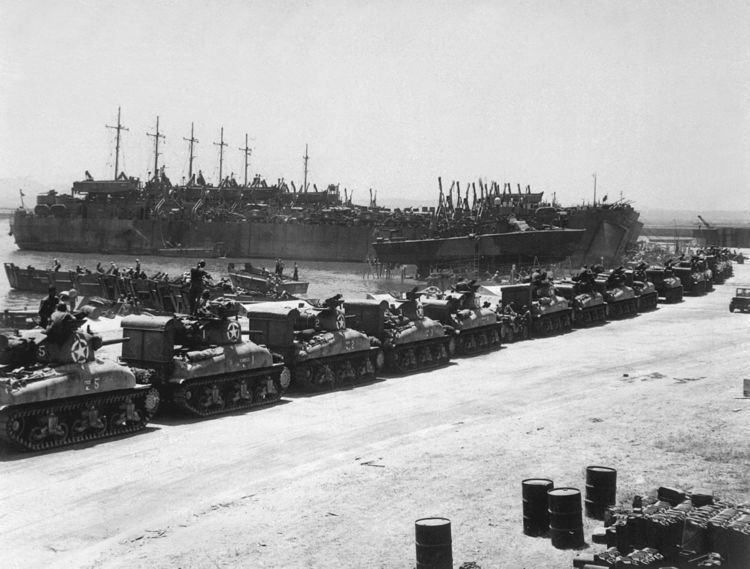Country United States Motto(s) "Audacity" | ||
 | ||
Active July 15, 1940–November 22, 1946January 17, 1949–? | ||
The 82nd Armored Reconnaissance Battalion was a part of the 2nd Armored Division, and was activated July 15, 1940 at Fort Benning, Georgia for World War II. The organization was made up of trained men, from cavalry and reconnaissance units. The reconnaissance battalion was known as the "eyes and ears", of the 2nd Armored Division.
Contents
History
The battalion mainly used the M-8 Light Armored Car, as it was fast, up to 56 mph (90 km/h), and gave some protection from small arms fire. M8 was equipped with a 37 mm gun and 6X6 wheel drive. The M8 was the main reconnaissance vehicle used by the US military in World War II. Also used was M20 scout car, which was a M-8 without the 37 mm gun and turret. In its place was an anti-aircraft ring mount for a .50-caliber machine gun. A bazooka was provided for the crew to compensate for its lack of anti-armor weaponry. With this vehicles, the 82nd could scout ahead of the slower M4 Sherman tank with a top speed of 25 mph to 30 mph. Also used for reconnaissance and to run messages Harley-Davidson WLA motorcycles were used by the 82nd as well. Almost all units used Jeeps as they were fast four-wheel drive utility vehicles.
North Africa
As part of the North African Campaign, three platoons of the 82nd were a part of the first landing in force in French North Africa's Tunisia which forced the surrendering. As part of Operation Torch and Operation Blackstone on November 8, 1942, one platoon of the 82nd landed at Safi, Morocco, and with Combat Command B another platoon landed at Fedala, near Casablanca, with the 9th Infantry Division and a third 82nd platoon landed at Mahdia Plage, near Port Lyautey, with the 3rd Infantry Division.
Sicily
As part of Operation Husky in the Sicily Campaign, the 82nd Armored Reconnaissance battalion played a big role in the capture of Butera when the battalion landed in Gela, Sicily in south-central Sicily, on July 11, 1943. While, the tank company also participated in the Battle of Mazzarino, then moving on to Palermo. After the liberation of Palermo it was a part of the Palermo Military District administering prisoners of war.
Omaha Beach to Berlin
On June 9, 1944, along with other battalions, the 82nd Battalion landed on Omaha Beach in Normandy as a part of Combat Command "A" as part of the Normandy landings and Operation Overlord. From Omaha Beach the battalion pushed through the Cherbourg peninsula and secured bridge across the Seine River. On January 16, 1944 near Mortain, France with Company "A", 2nd Platoon, the 82nd Reconnaissance helped link the Ninth U.S. Army with the 11th Armored Division, from the 3rd Army in the Ardennes.
Early September 1944 near Maastricht, Netherlands the battalion bridge over the Maas River, near Sittard. On September 2, 1944 parts of the 82nd moved into Belgium near Tournai. The battalion helped in the liberation of Born, Netherlands on Sept. 19, 1944. In Operation Queen and the Battle of the Bulge the battalion helped near Gereonsweiler and near Houffalize. In September 1944 some of the 82nd recon patrols entered Belgium 12 hours before other American troops. From there the 82nd helped the Division move from Roer river to the Rhine. For bravery in the drive from April 3, to April 17, 1945; from the Rhine to the Elbe river at Schönebeck, the 82nd Reconnaissance Battalion received the Presidential Unit Citation.
May 7, 1945 to January 1, 1946 the 82nd Reconnaissance Battalion moved to occupation roles, including serving among the first U.S. forces to occupy Berlin.
Back to the U.S
On January 21, 1946 the battalion was shipped from Calais, France to Fort Hood, Texas arriving February 12, 1946. The battalion was deactivated on November 22, 1946.
On January 17, 1949 the 82nd Reconnaissance Battalion was reactivated with new personal for tactical training in December 1949. On July 4, 1951 the battalion sailed out of New Orleans, Louisiana arriving July 17, 1951 at Bremerhaven, Germany, for its second tour of duty in Germany, during the Cold War.
